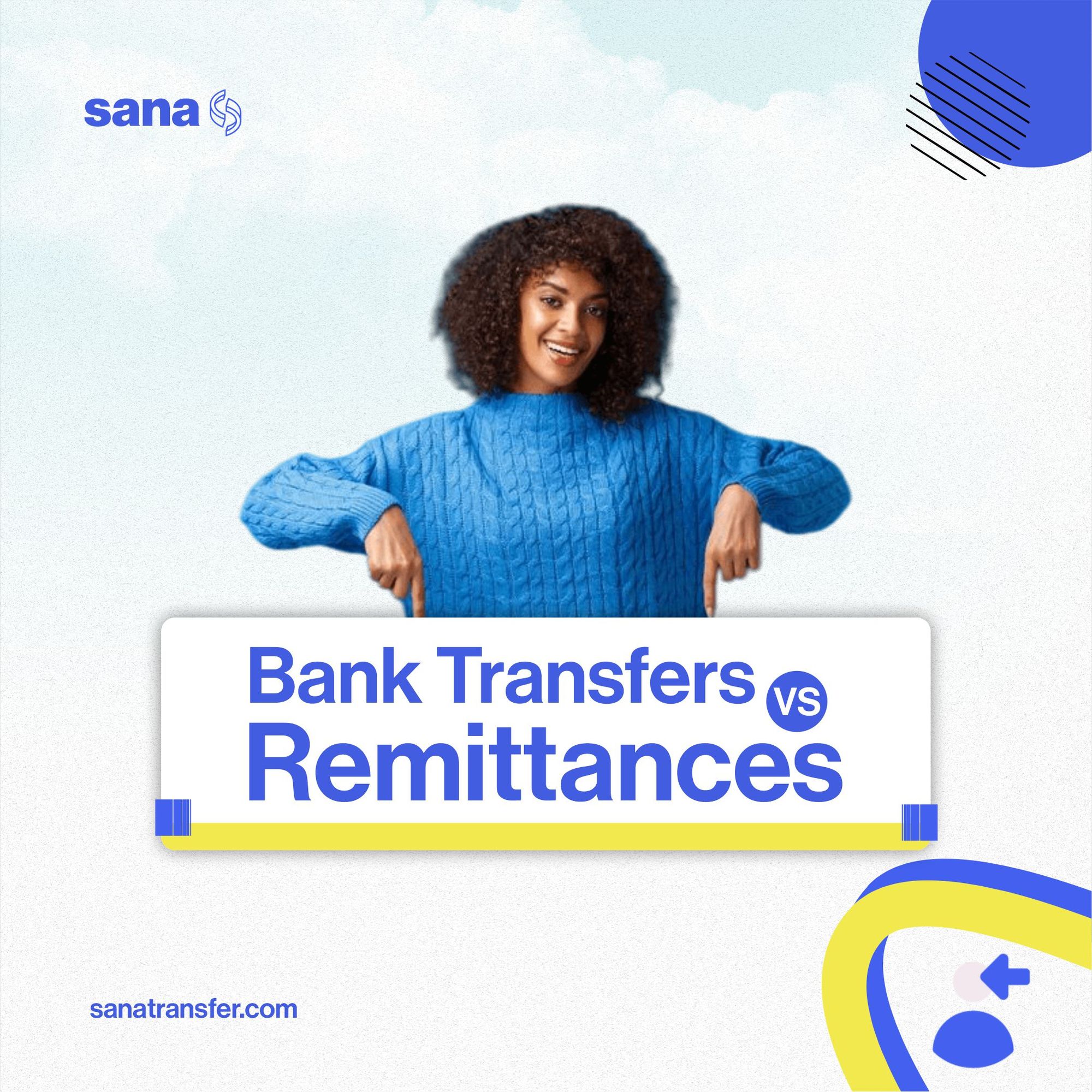Bank Transfers vs Bank Remittances Explained - What are the Differences?
In this article, we will be highlighting the major differences between bank transfers vs bank remittance.

The world of banking consists of many terminologies that are used to describe a variety of transactions. Two common terms that seem similar, yet, very different are “Bank Transfers” and “Bank Remittance”. Although many people even use these terms interchangeably, they are quite different from each other. In this article, we will be highlighting the major differences between bank transfers vs bank remittance. Knowing their differences will let you know which one is better suited for any kind of financial transaction you want to execute.
What is a Bank Transfer?
Bank transfer is simply the process of sending cash from one account to another digitally. Essentially, when you execute a bank transfer, you move funds from your bank account to another account through your bank. Also, when you receive funds, we can call it a bank transfer. It could be domestic or international transfers.
Bank transfers are usually completed quickly and give you the benefit of using local currency and low transaction fees.
The main difference between wire transfers and local bank transfers is the function of the intermediary or network. Generally, wire transfers make use of a direct connection between the two banks on both ends of the transfer. Like CIBC to HSBC for example.
Also, you can send local bank transfers at a moderately low cost, while international wire transfers generally incur large fees. Nevertheless, wire transfers are far more reliable than local bank transfers.
How do Bank Transfers Work?
Bank transfers are usually prompted from one bank to another. Instead of using cash, both of the participating financial institutions (or banks) share basic information about the receiver, the person’s account number, as well as the amount to be transferred.
The advantage of using bank transfers is that you don't need to provide too many details before you can send money to your recipient. You just need the basic information of your recipient and their bank to execute a transfer within a few seconds.
How to execute a Bank Transfer
We’ve outlined the most common steps for executing a bank transfer below:
1. The sender first logs in to their bank app or online banking platform and taps on the “bank transfer” app.
2. Next, the sender enters the bank account details of the recipient and provides his unique PIN to confirm the transaction.
3. The sender submits the request for their bank to send the applicable amount of money to the receiver's bank account.
4. Thereafter, the sender's bank sends the money to the receiver's bank. At this stage, the funds proceed to the clearing phase.
5. Once the clearing phase is completed, the recipient will receive the money in their bank account.
Although the bank transfer process can be quickly initiated, there is no guarantee that your recipient will receive the money immediately. Most times, it will take between 1-5 working days for the money to be available to the receiver.
Generally, bank transfer transaction fees are not much. Also, the sender or receiver may be mandated to pay an extra fee for exchange if the transfer involves converting from one specific currency to another currency. Bank transfers involve rigid security measures and this makes it a very safe way to transfer funds both locally and internationally.
Recommended - How to Send Money To Someone Without a Bank Account
What are Remittance Services?
Remittance services simply provide you with a way to transfer cash to a specific recipient with or without using a bank account.
Essentially, remittance transactions can be initiated over the counter using real cash or using a money transfer service provider app. Remittances are often called international money transfers.
It can also be said to be a way to send cash from one location to another, typically internationally. You can choose to either execute remittances digitally or use the cash pick-up option, where your recipient has to pick up the money at a specific location.
How do Remittance Services Work?
Generally, remittance transactions are mostly done by immigrants who want to transfer cash to their families who live in their home country. Although
remittances frequently charge senders a much higher fee than casual bank transfers, immigrants prefer this means because of the minimal requirements required to make use of the service.
When it comes to remittance services, both the sender and receiver don't need to own a bank account before sending cash. In fact, most times, the senders can even initiate a remittance transfer quickly without an account and the money will be almost instantly made available to the receiver. When it comes to remittance, there is no need for a clearing period, however, this also implies that remittance transactions may be more vulnerable to fraud.
How To Execute a Remittance
Below, we’ve outlined the common steps people take when executing a remittance.
1. The sender starts by logging into a mobile remittance app like SanaTransfer and creating an account on the app.
2. Next, the sender fills out the online remittance form by providing basic information about the receiver. This information includes the recipient’s full name, address, phone number, etc. Let’s assume you are using the Cash Pick-up method to send money to your recipient abroad.
3. Once the remittance request is confirmed, the total amount of money to be transferred and the fees are estimated and sent to the receiver.
4. The remittance app (Sana Transfer) will then generate a unique fund transfer control number for you. You will be asked to give this code to the recipient.
5. Once you give the code to the recipient, the recipient has to go to the nearest SanaTransfer cash pick-up approved branch to submit the code and the sender's information. Your recipient will also have to present a valid government-issued ID to claim the money.
From these steps, it is obvious that you and your recipient don't need to own a bank account before sending/receiving cash.
Many developing countries receive many inward remittances since recipients do not need to own a bank account before receiving funds. Only some basic requirements are needed to claim this cash, such as a valid ID. This means that almost everyone who is io to the legal age can get access to money sent from abroad.
Despite the generally higher transaction costs, remittance services still provide you with faster transactions, favourable exchange rates, and also have fewer conditions than conventional bank transfers. This makes them a very popular choice, especially for people sending smaller amounts of cash.
What is the Best Remittance App?
The best mobile app you can use to execute remittances is the SanaTransfer app. Essentially, SanaTransfer is a remittance service provider that allows people living in Canada to send money to their loved ones based in other countries around the world.
Read More - What is the Best App To Send Money From Canada to a Nigerian Bank Account?
Bank Transfers vs Bank Remittances - What are The Major Differences?
Now, we will be comparing the differences between bank transfers and remittances based on certain criteria. Check out the list below:
1. Requirements
a. Bank Transfers
To execute a bank transfer, you have to own a bank account. Essentially, this implies that you must have a maintaining account balance, your proof of residence, and could even be mandated to go through a background check or a credit report. All of these requirements apply to both the sender and receiver of the cash.
b. Remittances Services
Generally, remittance services only need you to provide a single valid government-issued ID, the phone number, address, and other basic details of the recipient. Due to this minimal requirement needed, almost anybody can use the remittance services to send funds to their loved ones abroad.
2. Speed of Transaction
a. Bank Transfers
It is common for a recipient to get frustrated waiting for a bank transfer to clear before receiving the funds. With factors like banking days, cut-off times, and even clearance times, it may take about one week for bank transfers to complete.
b. Remittance Services
Recipients can receive and claim cash from a remittance almost immediately after the transaction is completed. So generally, remittances are faster than regular bank transfers.
3. Security
a. Bank Transfers
One thing bank transfers are known for is security. Banks put active measures to guarantee the security of all their customers. The long and strict requirements required to open a bank account are a clear reminder of this fact. If a bank transfer goes wrong, banks have placed active dispute processes to protect your interest.
b. Remittance Services
Remittance services only need minimal requirements to get executed and this gives room for fraudulent activities. Fraudsters commonly use this service to receive payment since all they need is just a fake ID and going after them is almost impossible.
4. Transaction Amount
a. Bank Transfers
Bank transfers generally allow you to send large amounts of money to the recipient. Also, the safety that banks provide will grant you peace of mind whenever you are sending a huge amount of money to a third party. Although it may take longer for the transaction to be completed, at least you have rest of mind that your cash will still arrive at the intended destination.
b. Remittance Services
Remittance services are generally suitable for smaller transactions. Nevertheless, the limits on your remittance transaction are quite lower than regular bank transfers. So if you want to send small money, it may be better to use this option as the risk involved here when you want to send a large amount of money is more significant.
5. Ease of Use
a. Bank Transfers
Bank transfers are highly accessible for all senders, as you can execute all bank transactions online in just a few minutes through electronic banking. Most bank transfers can be executed from the convenience of your own home. However, recipients may have to wait for a longer time for the money to be available.
b. Remittance Services
Remittances can be executed via a money transfer service provider online or through their app. However, you may still need to process your remittance transfer over the counter. Receivers in most developing countries will need to visit a remittance center to claim the transfer. However, remittances are not hindered by clearing times, hence, recipients can access the funds instantly.
Bottom Line
From the above comparison, we’ve concluded that bank transfers are generally more suitable for larger amounts of money where security is far more important than transaction speed. On the other hand, remittances are ideal when sending smaller amounts of money, especially when speed is of the essence.
SanaTransfer offers easy, fast and secure payment services with better rates and faster payouts for international remittance. Sign up now to get started.
